- The paper demonstrates that SMBH growth at Cosmic Dawn is bursty and self-regulated by the stochastic, multiphase ISM driven by stellar feedback.
- It employs high-resolution zoom-in simulations varying SMBH seed mass, accretion physics, and AGN feedback to identify conditions for self-regulation.
- Results indicate that reproducing JWST-observed overmassive SMBHs requires super-Eddington accretion and weak AGN coupling without quenching star formation.
Supermassive Black Hole Growth in Massive Galaxies at Cosmic Dawn
Introduction and Motivation
The formation and rapid growth of supermassive black holes (SMBHs) in the early universe, particularly within the most massive galaxies at z≳9, is a central problem in galaxy evolution. Recent JWST observations have revealed an excess of massive, luminous galaxies at Cosmic Dawn, many of which exhibit AGN signatures and host SMBHs that appear overmassive relative to their stellar hosts. This paper presents a suite of high-resolution cosmological zoom-in simulations using the RAMSES AMR code, designed to probe the physical mechanisms governing SMBH growth and feedback in these rare, massive dawn galaxies (MDGs). The simulations systematically vary SMBH seed mass, accretion physics (including super-Eddington regimes), and AGN feedback efficiency, with the goal of elucidating the interplay between SMBH accretion, stellar feedback, and the turbulent, multiphase ISM at high redshift.
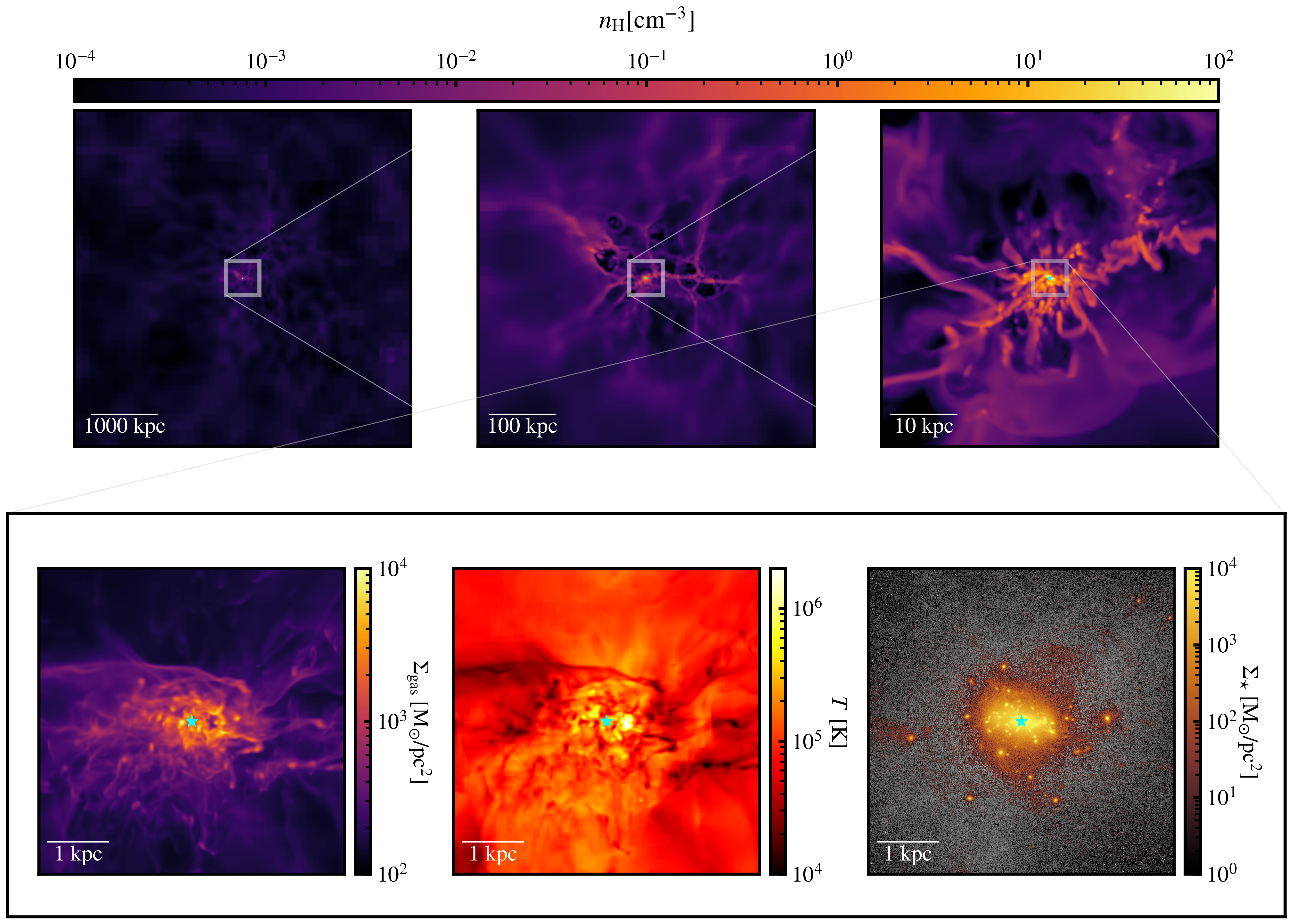
Figure 1: A zoom-in simulation of a massive Cosmic Dawn galaxy at z=9 with a central SMBH regulated by AGN feedback. The top row shows gas density slices; the bottom row shows projected gas surface density, temperature, and stellar surface density over dark matter. The cyan star marks the SMBH.
Simulation Methodology
The simulations employ a cosmological zoom-in approach, targeting a 1011 M⊙ halo at z=9 within a (100 h−1 cMpc)3 box. The minimum cell size in the zoom region is Δxmin∼10 pc, enabling resolution of the turbulent ISM and star-forming clumps. Star formation is modeled using a turbulence-based, multi-freefall prescription, with local SFE determined by subgrid turbulent energy and a log-normal density PDF. Stellar feedback includes both early (photoionization) and late (Type II SN) channels, with energy and momentum injection calibrated to resolved and unresolved SN remnants.
SMBHs are seeded in dense clumps (Mseed=104 or 105 M⊙) identified by the PHEW clump finder, with accretion governed by a modified Bondi-Hoyle-Lyttleton formalism, including a density-dependent boost factor to account for unresolved clumping. The accretion rate is capped at λeddM˙edd, with λedd varied from 1 (Eddington-limited) to ∞ (no limit). AGN feedback is implemented as isotropic thermal energy injection within the sink sphere, with coupling efficiency ϵc varied between 0 and 15%.
Analytical Framework: Accretion Regimes and Self-Regulation
The paper develops an analytical model for SMBH growth, focusing on the competition between AGN heating and radiative cooling within the nuclear region. Two regimes are identified:
- Cold Accretion Regime: Cooling dominates, the SMBH accretes at the (super-)Eddington rate, and growth is exponential with timescale τsal/λedd.
- Hot Accretion Regime: AGN heating dominates, the accretion rate drops below Eddington, and the SMBH can self-regulate by unbinding gas from the nuclear region.
The transition between these regimes is set by a critical SMBH mass Msink,critcool, above which AGN heating overcomes cooling. A second threshold, Msink,critesc, marks the mass at which AGN feedback can unbind gas from the halo, setting the self-regulated mass scale. Both thresholds are explicit functions of the sink radius and thus resolution-dependent.
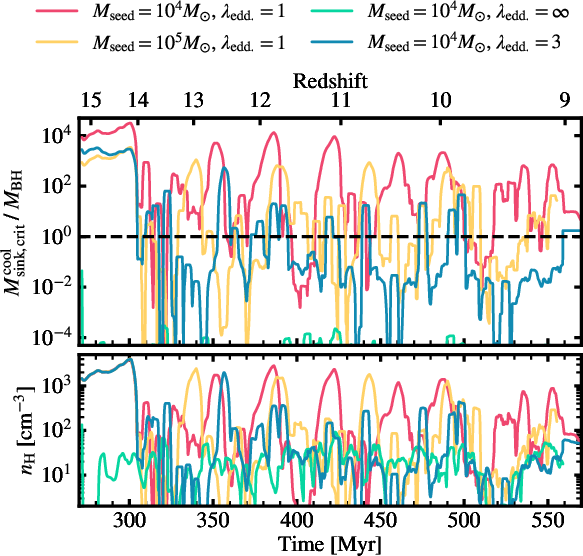
Figure 2: The critical mass threshold Msink,critcool for AGN heating to dominate over cooling, as a function of time, compared to the actual SMBH mass in each simulation.
Results: SMBH Growth and the Role of the Multiphase ISM
Bursty Accretion and Starvation
After the onset of star formation (t∼300 Myr), stellar feedback drives a turbulent, multiphase ISM, with the nuclear region alternating between cold-dense and hot-diffuse phases. The SMBH accretion history becomes bursty: periods of maximal (Eddington-limited) accretion ("feast") are interspersed with intervals of starvation when the SMBH is embedded in hot-diffuse gas. The fraction of time spent in the feast mode, α, is ∼0.5 for the fiducial feedback model, implying that SMBH growth is suppressed by a factor of two relative to uninterrupted Eddington accretion.
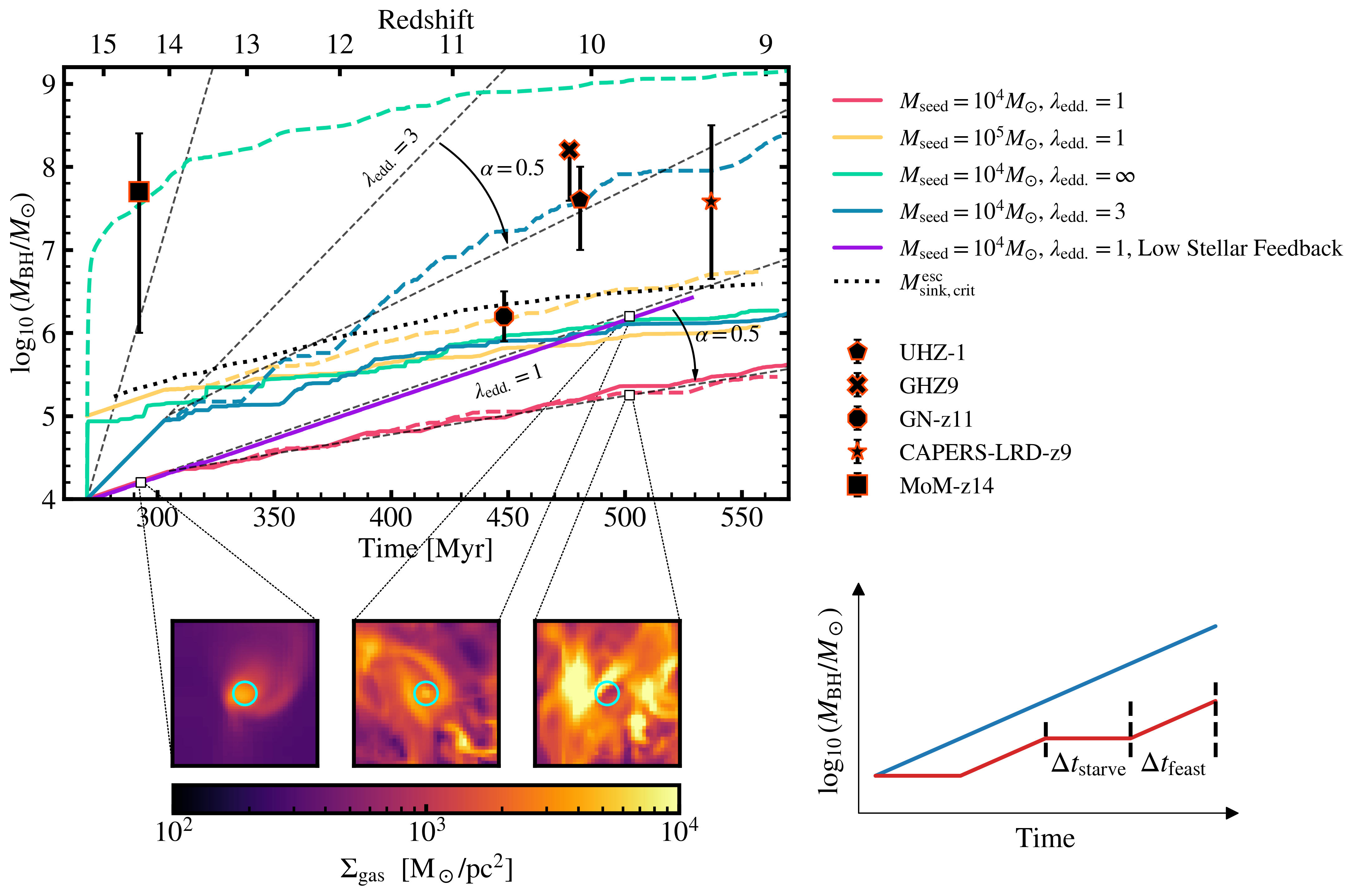
Figure 3: Mass evolution of the SMBH as a function of time for all simulations. Solid lines: AGN feedback on; dashed: off. Black dashed lines: exponential (super-)Eddington growth. Black dotted: self-regulated mass threshold.
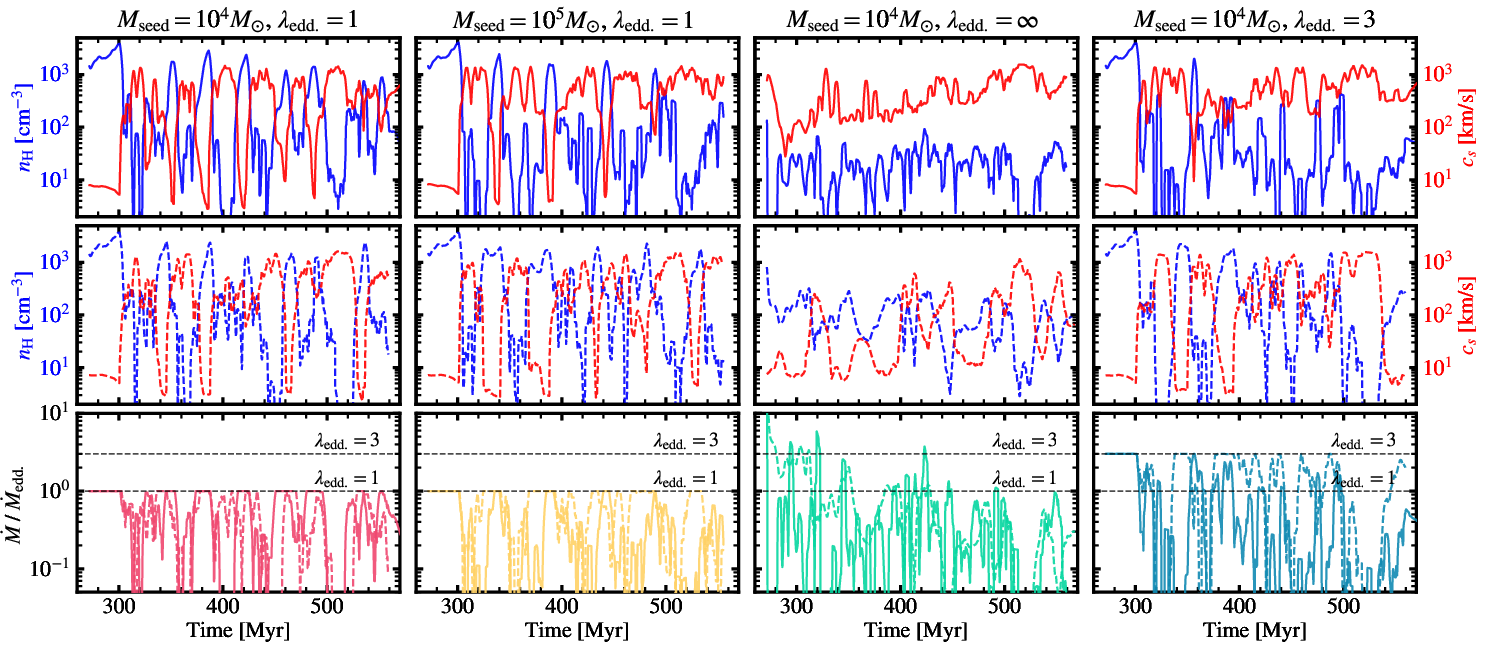
Figure 4: Sink sphere properties (density, sound speed, accretion rate) as a function of time for different feedback/accretion models.
Self-Regulation and AGN Feedback
Self-regulation by AGN feedback is only achieved if the SMBH becomes sufficiently massive (by accretion or seeding) to exceed Msink,critcool for a significant fraction of time in hot-diffuse ISM phases. If this condition is met, AGN feedback can mediate the nuclear ISM, suppressing further accretion and causing the SMBH to track the self-regulated mass Msink,critesc. If not, the SMBH remains regulated by stellar feedback and the stochastic ISM, and self-regulation is delayed until later epochs.
A key result is that the ability of the SMBH to self-regulate is not guaranteed; it depends on the interplay between seed mass, accretion rate, AGN feedback efficiency, and the stochasticity of the ISM. In simulations with low AGN coupling or low seed mass, the SMBH fails to self-regulate at z∼9.
Across all simulations, AGN feedback has negligible impact on the global star formation rate (SFR) and final stellar mass by z=9. The SFR is set by the halo accretion rate and is robust to AGN-driven heating, due to the continuous replenishment of cold gas from cosmic filaments.
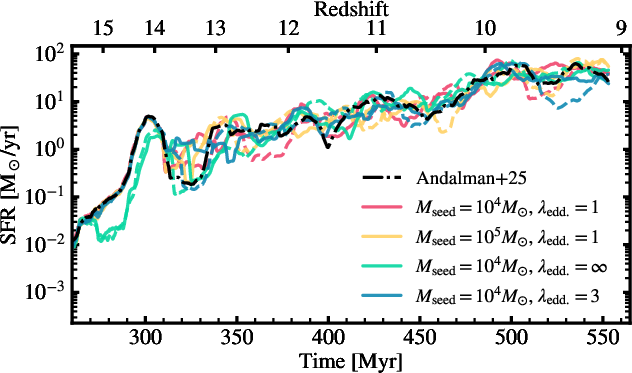
Figure 5: SFR as a function of time for all simulations. AGN feedback does not quench star formation at z∼9.
The simulated MBH-M⋆ relation shows that, for Eddington-limited or self-regulated SMBHs, the final MBH/M⋆ is consistent with local relations, but underpredicts the overmassive SMBHs observed by JWST. Only simulations with super-Eddington accretion and/or low AGN coupling efficiency can reach the observed high MBH/M⋆ ratios.
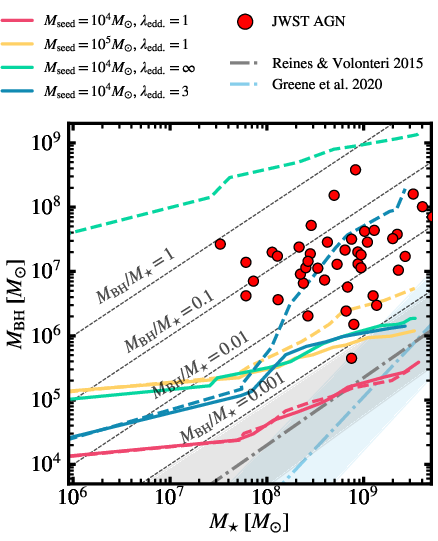
Figure 6: SMBH mass versus stellar mass for all simulations, compared to local and high-z observational constraints.
Timescale Analysis and Physical Interpretation
The paper analyzes three key exponential growth timescales: the SMBH Salpeter timescale (τsal), the halo mass growth timescale (τhalo), and the self-regulation timescale (τesc). At z∼9, τhalo∼τsal, implying that the SFR (set by halo accretion) always outpaces SMBH growth unless λedd≫1. This explains the resilience of star formation to AGN feedback at early times.
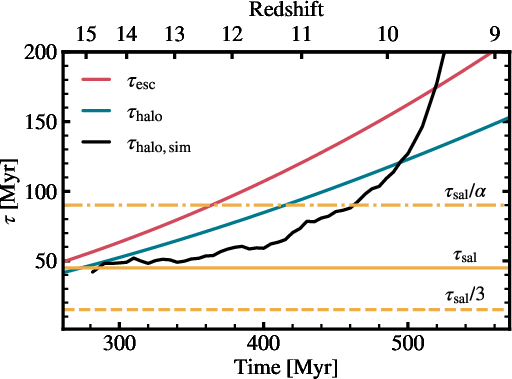
Figure 7: Exponential growth timescales as a function of time: τesc (red), τhalo (blue), τsal (yellow).
The analysis also shows that the critical mass thresholds for self-regulation and AGN heating are resolution-dependent, highlighting the need for improved subgrid models and higher-resolution simulations to robustly predict SMBH masses.
Comparison to Observations and Implications
The simulations are compared to recent JWST detections of high-z AGN and overmassive SMBHs. The key findings are:
- Self-regulated SMBHs at z∼9 are under-massive by 1–2 dex compared to JWST-inferred SMBH masses, unless AGN feedback coupling is extremely inefficient (ϵc≲0.15%) and/or super-Eddington accretion is allowed.
- The observed overmassive SMBHs can be reproduced in models with high seed masses, super-Eddington accretion, and weak AGN feedback, but these scenarios are sensitive to subgrid assumptions and resolution.
- The lack of AGN-driven quenching at z∼9 is a robust prediction, consistent with the high SFRs observed in MDGs.
Theoretical and Practical Implications
The results challenge the universality of AGN self-regulation at high redshift and emphasize the dominant role of the turbulent, feedback-driven ISM in modulating SMBH growth. The findings suggest that the MBH-M⋆ relation is not established at Cosmic Dawn, and that the observed overmassive SMBHs require either non-standard accretion physics or a revision of AGN feedback models. The explicit resolution dependence of the critical mass thresholds underscores the need for next-generation simulations with ∼pc-scale resolution and improved treatments of radiative, kinetic, and cosmic ray feedback.
Conclusion
This paper provides a comprehensive numerical and analytical investigation of SMBH growth in massive galaxies at Cosmic Dawn. The main conclusions are:
- SMBH growth is highly sensitive to the stochastic, multiphase ISM generated by stellar feedback, leading to bursty accretion histories with significant starvation.
- Self-regulation by AGN feedback is not guaranteed and depends on the SMBH mass, accretion rate, and feedback efficiency.
- AGN feedback does not quench star formation in MDGs at z∼9 due to rapid halo accretion and gas replenishment.
- Reproducing the overmassive SMBHs observed by JWST requires super-Eddington accretion and/or weak AGN coupling, but these results are sensitive to subgrid and resolution effects.
Future work should focus on higher-resolution simulations, improved feedback models (including radiative transfer and non-equilibrium chemistry), and direct comparison to the growing sample of high-z AGN from JWST. These efforts are essential for constraining the physical pathways to early SMBH formation and the co-evolution of galaxies and their central black holes.






